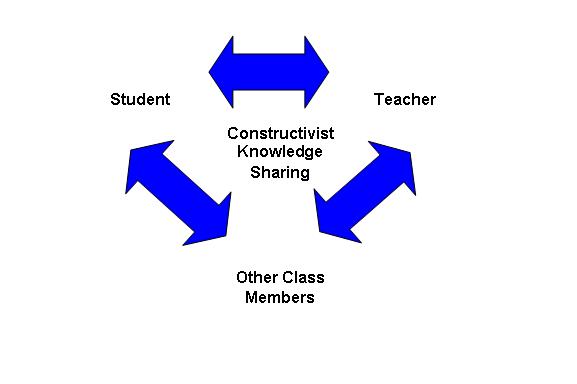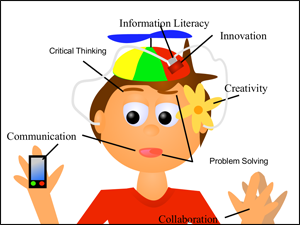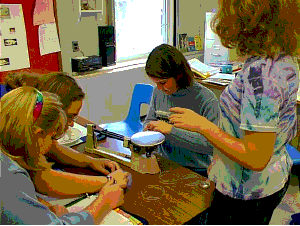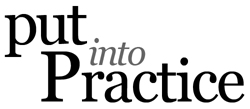Social Constuctivism
Social Constructivism- What is it?
"... a known truth owes its existence to the mind that knows it..." -Giamattista Vico, 1668-1744
Social constructivism emphasises that all cognitive functions including learning are dependent on interactions with others (e.g. teachers, peers, and parents). Therefore learning is critically dependent on the qualities of a collaborative process within an educational community, which is situation specific and context bound (Eggen and Kauchak, 1999; McInerney and McInerney, 2002; Schunk, 2012). However learning must also be seen as more than the assimilation of new knowledge by the individual, but also as the process by which learners are integrated into a knowledge community.
According to social constructivism nothing is learnt from scratch; instead it is related to existing knowledge with new information being integrated into and expanding the existing network of understanding. The successful learner is therefore one who embeds new ideas within old and for whom understanding expands to encompass the new experience. Therfore, a social constructivistic learner's view of the world will always be subjective, as each individual will interpret experience via a different pre-existing framework of understanding and will develop their own unique view of the world.
Social constructivism in its modern form has been in existence for approximately 40 years. Strictly speaking while it is thought of as a learning theory,with roots in cognitive constructivism (Piaget, 1950) and sociocultural theory (Vygotsky, 1978) it is more correctly an epistemology or philosophical explanation about the nature of learning (Hyslop-Margison and Strobel, 2008).
The nature of knowledge in social constructivism
According to social constructivism, knowledge is a human product, which is socially and culturally constructed in an active manner and not something which can be discovered ( Geary, 1995; Gredler, 1997; Ernest, 1999 ). Knowledge is therefore neither tied to the external world nor wholly to the working of the mind, but it exists as the outcomes of mental contradictions that result from ones interactions with other people in the environment (Schunk, 2012).
The nature of learning in social constructivism

Social constructivism maintains that learning is based on real life adaptive problem solving which takes place in a social manner through shared experience and discussion with others such that new ideas are matched against existing knowledge and the learner adapts rules to make sense of the world. Social constructivism places the focus on the learner as part of a social group, and learning as something that emerges from group interaction processes, not as something which takes place within the individual. Learning is seen as an active socially engaged process, not one of a passive development in response to external forces (McMahon, 1997; Derry, 1999 ). To the social constructivist, to learn is to see the meaning or significance in a social experience or concept. Therefore social constructivism acknowledges the uniqueness and complexity of the individual learner and values, utilizes and rewards it as an integral part of the learning process (Wertsch 1997).
The nature of reality in social constructivism
Social constructivists believe that reality is constructed not discovered through human activity, so that societies together invent the properties of the world (Kukla, 2000). According to social constructivists, the process of sharing individual perspectives, or collaborative elaboration (Meter & Stevens, 2000), results in learners constructing understanding together that wouldn't be possible alone (Greeno et al., 1996). Social constructivism maintains that while it is possible for people to have shared meanings which are negotiated through discussion, it also acknowledges that no two people will have exactly the same discussions with exactly the same people. To this extent social constructivism allows that multiple realities exist.
The nature of motivation in social constructivism
In social constructivism the motivation of the learner is regarded as having both intrinsic and extrinsic roots. The intrinsic motivation is created through curiosity about the world and the extrinsic motivation is provided by the rewards which can be accessed through the knowledge.
Social constructivism is most closely associated with the work of the developmental theorist Lev Vygotsky and psychologist Albert Bandura but it is also nested within the theories of Dewey, Piaget and Bruner (Schunk, 2012). The linked pages aims to provide a brief resume of the pertinent aspects of these theorists work in relation to social constructivism.
Active Learner
Social constructivism views learning as an active process where learners should learn to discover principles, concepts and facts for themselves (Brown et al., 1989). This approach does not see a class as a place where the teacher/tutor pours knowledge into passive students, instead it emphasises how students should be actively involved in their own process of learning.
Social interaction and the creation of meaning
.jpg)
A main focus of social constructivism is the role that social interaction and social processes play in creating knowledge. Vygotsky believed that learning could not be separated from social context. He argued that all cognitive function begins as a product of social interactions. Social constructivism requires one primary element, two or more participants. These participants must be involved in some form of interaction for knowledge to be constructed and they must have knowledge of prior social experience (Gergen, 1995). It is a shared understanding among individuals whose interaction is based on common interests that form the ground for their communication. Therefore, during the interaction between the participants’ this prior knowledge is exchanged in a transaction in order to negotiate a meaning. This meaning does not have to be strictly language based, but can also be a product of actions. Thus, construction of social meanings involves intersubjectivity among individuals and any personal meanings shaped through this will be affected by the intersubjectivity of the community to which the people belong.
A key emphasis of social constructivism is the value of cultural background. Every human develops in the context of a culture, thus a child’s learning is affected by the culture of their family they are brought up in. According to social constructivism, culture gives the child much of the content of their thinking, that is their knowledge. Secondly it provides the child with the cognitive tools needed for development, thus culture can teach children both what to think and how to think. Adults in the child’s environment are conduits for these tools, which include language, cultural history, social context and more recently electronic sources of information.
The role of culture in learning is a complex one. Bruner (1996) stated that what a person learns is framed by the surrounding culture and learning is a sharing of that culture. Thus according to Bruner (1996) all learning is induction into a culture including all the values of that culture. Social interaction, via working in groups with peers, is essential to social constructivism and these peer group interactions have been shown to create a culture that is open to learning. Social interaction with other children, adults and the physical world is important in developing a child’s thinking abilities. Social constructivism encourages the learner to arrive at his or her version of the truth influenced by their culture. One’s language, logic and other symbol systems are inherited by the learner as a member of a particular culture and these are learned throughout the learner’s life.
However, sometimes children can have difficulty learning because the instruction from a teacher/tutor does not follow the child’s cultural values.
Example
Au and Mason (1981) found that Native Hawaiian students performed poorly in reading lessons, showing a considerable degree of inattentiveness, when teachers conducted lessons following the rules for conventional classroom recitation. These students paid more attention to reading, discussed more text ideas, and made more logical inferences about the text when their reading lessons were conducted in a culturally responsive manner. In the culturally responsive lessons, the teacher allowed the students to follow rules for participation much like those in talk story, a common speech event in the Hawaiian community. In talk story-like reading lessons, unlike classroom recitation, the students could collaborate in producing responses and there was a high degree of overlapping speech.
This example illustrates how a social constructivist approach, including collaborative learning, can be flexible among many cultures, as it gives children more freedom to work together in a way that is suited to their cultural values and standards for behaviour.
Below is a YouTube video of an example where a social constructivist approach has been successfully implemented in an American school, in order to help the children learn about and understand the British literature they were reading. Again emphasising the multicultural use of social constructivism.
Social constructivism as distinct from constructivism
Social constructivism is distinct from cognitive constructivism in that social constructivism arose out of concerns regarding the role of the teacher in the classroom. Social constructivism is concerned with the importance of collaboration with others, either student with student or student with teacher and views social interaction as the primary means by which learners construct new meanings (Vygotsky, 1998).
Social constructivism is different to constructivism in that the latter views learning as following development as the learner acts on his environment, while the former views learning as leading development and as something that occurs as the learner engages in social activities with others.
According to social constructivist theory, cognition and learning exist in a dialectical relationship with the social world, whereby discussion is utilised to resolve cognitive conflict and as a result produces higher levels of mental functioning. Conflicts are resolved through a social process and knowledge is something that is distributed across, between and within individuals and the collective. This knowledge is not transmitted from the social world to the learner but is appropriated and transformed as individuals engage with others - which is an active process (McMahon, 1997). Therefore knowledge is emergent as the learner acts upon the social context and the social context acts upon the learner.
Social constructivism as distinct from Sociocultural theory
Social constructivism is related to but distinct from sociocultural theory (Vygotsky, 1978). While both theories give importance to the contextual nature of learning and the construction of knowledge, sociocultural theory places emphasis on the mediating role of historically situated cultural tools and artefacts. In other words it is not the social context alone which produces new understandings, but also the cultural tools and artefacts within it that produce and shape new knowledge (Cole and Wetsch, 1996).
Social Constructivism as distinct from Social Constructionism
Social constructivism and social constructionism differ in that social constructivism focuses on the Vygotskian notion that the individual mind is first social and then individual and also of the importance of social context in learning. In contrast, social constructionism’s primary emphasis is on discourse as a vehicle for constructing knowledge (Gergen, 1999). The difference between the two theories rests on the role of the individual mind. In social constructivism, the individual mind internalises ways of learning through collaboration with others in social context, while social constructionism eschews the notion of the mind as an individual container and instead focuses on what happens between the minds of people.
To recap, social constructivist perspectives rely on the interdependence of social and individual procedures, making clear that the absorption of knowledge is a cooperative process that exists between many (Palincsar, 1998).

With this in mind, according to the social constructivism theory, instructors should assume the position of ‘facilitators’and not teachers (Bauersfeld, 1995). The differences are; a teacher is an imparter of knowledge, whereas a facilitator encourages the learner to achieve their own appreciation of the content. In the first scenario, the learner can quite easily play an unreceptive role, whereas with a facilitator they are encouraged to play a more functional and effective role within their own learning.Therefore, the importance is placed on the learner and what they’re capable of (Gamoran, Secada, & Marrett, 2006). Moreover, this dramatic difference in the expectation of a facilitator as opposed to a teacher suggests that within social constructivist learning, the educator plays a largely different role to what is expected of a teacher (Brownstein, 2001).
For example, a teacher offers answers that are in line with a traditional program, while a facilitator offers strategies that allow the learner to achieve his or her independent conclusions (Rhodes and Bellamy, 1999).
The learning environment should also be designed to support and challenge the learner’s thinking. The critical goal is to support the learner in becoming an effective thinker (Di Vesta, 1987).
“I'm trying to free your mind, Neo. But I can only show you the door. You're the one who must walk through it.” ~Morpheus, The Matrix 

In a social constructivistic educational setting the responsibility for learning falls on the learner, while the teacher is a facilitator, who guides direction and promotes new patterns of thinking.
The learner is primarily expected to
- be engaged with his peers and the teacher in discussion and active exploration of the topic of interest
- be exploratory and creative in self-directed research and development of new theories through innovative analysis, conceptualizations, and synthesis of prior experience to create new knowledge.
- to look for meaning and to try to find regularity and order in the events of the world even in the absence of full or complete information. In addition the responsibility for learning is seen to reside within the learner (von Glasersfeld, 1989).
The goal of any social constructivist teaching exercise is to develop skills in heuristic problem solving, metacognitive knowledge, creativity, and originality as a by-product of increasing the level of understanding in knowledge on the topic of interest.
What is it?
Social constructivism stresses the need for collaborative learning. Learning is promoted through collaboration among students, and between students and teachers. From a social constructivist perspective, as students share background knowledge and participate in the give and take of collaborative activities they are actually negotiating meaning and building knowledge, not as individuals, but as a group. This collaboration in tasks and discussions allows learners with different skills and backgrounds to arrive at a shared understanding of the truth (Duffy and Jonassen). Social constructivist approaches should require the students to collaborate and critically analyse the issue at hand. Some examples of collaborative learning activities are group problem solving, group inquiry, simulations, and debates. The activities encourage creativity, value and also foster higher-level thinking (Brown, 1999). In collaborative learning students are working towards a common goal and are responsible for another’s learning as well as their own. For instance, peer tutoring where students in the same group tutor one another facilitates meaning in both parties, as the peer tutor clarifies their own understanding through the teaching process.
Collaborative learning develops social skills. In primary education there is a hierarchy of social skills that must be learned, therefore by higher education students should already have these basic social skills to allow them to participate in collaborative activities and engage in social interaction in learning. However, collaborative learning in higher education will continue to develop these skills along with more complex social skills.
Benefits of collaborative learning
Listed below are some of the beneficial reasons why social constructivism stresses the use of collaborative learning in higher education.
1. Develops higher level thinking
Students working together are engaged in the learning process instead of passively listening to the teacher present information. When students work in pairs both are developing valuable problem solving skills by formulating their ideas, discussing them, receiving immediate feedback and responding to questions and comments by their partner (Johnson, D.W. 1971).
2. Increases student’s retention
Students who are actively involved in the learning process are much more likely to become interested in learning (Astin 1977). The interactive environment associated with collaborative learning produces high student motivation and participation and is more likely to increase student attendance (Garibaldi 1976; Treisman 1985).
3. Builds self-esteem in students
Everyone benefits from a collaborative learning environment. Students help each other and in doing so support each other, which raises the performance level of each member (Kagan 1986). This support system in turn leads to higher self-esteem in all students (Webb 1982).
4. Develops social interaction skill
Collaborative learning helps build and develop many valuable social skills. Often in society competitive skills are encouraged and valued, however collaborative learning allows co-operative skills to be learned, so that students can work together.
5. Fosters team building and a team approach to problem solving while maintaining individual accountability.

A major function of collaborative learning is team building. This is accomplished through a variety of techniques, such as warm up activities, getting to know class members' names, practice exercises, group building exercises and more. Regarding individual accountability, some form of assessment is used to determine how well individual students have mastered the material (Slavin 1983b). Quizzes during the semester may also be given individually, thus maintaining a strong element of accountability by each group member.
6. Stimulates critical thinking and helps student clarify ideas.
The level of discussion and debate within groups is substantially greater than when an entire class participates in a teacher led discussion. Students receive immediate feedback or questions about their ideas and formulate responses without having to wait for long periods of time to participate in the discussion (Peterson & Swing 1985). The level of discussion becomes much more sophisticated and the teacher may question ideas or statements made by group members or to clarify questions raised by students, thus stimulating more critical thinking in students.
7. Enhances self-management skills
Collaborative learning requires self-management by students in order for them to be an effective group member. In order to perform well in a group, students need to be prepared and complete assignments so that they understand the material which they are going to contribute to their group.
8. Fosters and develops interpersonal relations
The socially interactive nature of collaborative learning processes improves interpersonal relationships among students. Collaborative learning encourages out of class work by groups of students, bringing them together in a combined academic and social experience.
9. Allows learning from peers
Students often learn more by listening to their peers than they do by listening to an authority figure like a teacher (Levin et al., 1984). Peers often have a better understanding of what other students don't know or how is best to explain something in simple terms. In addition to shifting responsibility for learning onto students, collaborative learning allows students to demonstrate their own knowledge by helping their peers (Bargh & Schul 1980).
10. Students practice roles useful to real working jobs
In collaborative learning students may be assigned roles within their group, thus students are encouraged to develop and practice the skills which will be needed to function in society and the real working world (Houston 1992). These skills include leadership, information recording, communication of results orally and in writing, challenging ideas in a constructive manner, obtaining and distributing materials and information to group members, encouraging member participation, brainstorming, meeting deadlines, etc (Sandberg 1995). Wlodowski (1985) observes that, "If students realise the direct applicability of classroom small group problem-solving to their own lives, motivation to learn will show a marked increase."
Why teachers may resist collaborative learning

Currently, not all tutors are implementing collaborative learning in higher education. Some of the reasons suggested by Panitz and Panitz (1996) as to why teachers resist collaborative learning are listed below.
- Loss of control in the classroom
- Lack of self-confidence by teachers
- Fear of the loss of content coverage
- Lack of prepared materials for use in class
- Lack of familiarity with other student assessment techniques
- Lack of student or parent understanding of the use of collaborative learning.
How Educational Practices are Influenced- Theory?
There are various ways by which learning,instruction and other educational practices have emerged and changed due to the development of social constructivism.
Social constructivists put forward the importance of both the context in which learning takes place and the social contexts that learners produce within their learning environment. There are four generally considered perspectives that enlighten how we could further learning within then context of social constructivism (Gredler, 1997.)
Idea based social constructivism:
This concentrates on various essential topics that are of great importance to the learning experience of students.These involve numerous key or core themes that are vital within the learning experience of the students. These key concepts are thought to ‘expand learner vision’ and are said to be the building blocks for later learning (Gredler,1997).
Transactional/situated cognitive perspectives:
This viewpoint pays attention to the impact that the environment can have upon learning. This perspective understands that learning is affected by the environment that children are indue to the social relationships that occur within their educational setting.This perspective appreciates the importance of a change in the social dynamic within a classroom and it is aware of how this can affect the learning experience.
Pragmatic/emergent approach:
Social constructivists who adopt this viewpoint contend that the execution of social constructivism in class is only necessary when the need arises (Gredler, 1997.) Its supporters contend that awareness and understanding of the world can be tackled in the classroom through two different means; the individual learner and the shared view of the whole class (Cobb, 1995.)
Cognitive tools perspective:
This view places emphasis on the learning of cognitive skills and the tactics that learners employ to achieve these. The importance of this theory surrounds group learning. It argues that together, learners engage in a social learning process that is effective for everyone involved. This theory argues that students benefit from practical based approaches and the use of specific cognitive instruments (Gredler, 1997.)
In practice learning activities in a social constructivist educational setting are based around joint activities between teachers and learners which are both exploratory and collaborative (Wells, 2000). In this context both students and teachers are viewed as active agents in the construction of knowledge.
This is supported by the development of an emergent curriculum which allows for diversity and dialogue in the ways of solving problems which build on the prior knowledge that the students and the teacher bring to allow a shared understanding. It is of note that this means that the student as well as the teacher can take the role of learner in the social constructivist classroom.

In a social constructivist classroom the focus shifts from the teacher to the students, and discussion and interaction on the topic is actively encouraged. The teacher’s main function is to begin or direct a discussion amongst the learners and to maintain its direction and focus. Discussion can be promoted by the presentation of specific concepts, problems or scenarios, and is guided by means of effectively directed questions. The learners are urged to be actively involved in their own process of learning, setting their own questions for discovery and challenging assumptions made both by themselves and by others. Innovative classroom strategies such as problem based learning are undertaken, so that learners ask questions, investigate a topic, and use a variety of resources to find solutions and answers. The learners are encouraged to work cooperatively, sharing in responsibility and goals. Therefore the goal in many tasks is to illuminate the subject, to interpret and share and learn from other points of view and to piece together the puzzle using everyone's contribution. The social constructivist classroom relies on Vygotsky’s principles of instructio nal scaffolding, reciprocal teaching and peer collaboration.
According to Siemens (2005) , "Constructivist principles acknowledge that real-life learning is messy and complex. Classrooms which emulate the 'fuzziness' of this learning will be more effective in preparing learners for life-long learning".
The constructivist classroom is a busy place which encourages movement and interaction amongst individuals and groups. It might be laid out in a more open way than a traditional classroom and will typically have a variety of resources available to the learners to allow them to have a choice in how to progress with investigation on the topic. There is also no timetable for learning and each individual is encouraged to advance at their own pace and using their own methods. This practice encourages retention of knowledge and skills in the individual.
Strategies which can be used in the classroom to encourage social constructivist learning include:
In higher Education some of the ways to put social constructivism into practice include:
- Reciprocal questioning - which encourages working together to ask and answer questions
- Jigsaw classroom activities - where a small groups of students become expert on one part of a bigger problem and each group educates the others on their specialty to attain overall conceptual understanding
- Structured Controversies – where students work together on a common goal.
- Encouraging student autonomy and initiative
- Discussion even in lectures, promoted by the educator asking open questions and allowing time for responses
- Encouraging the connection of ideas via analysis, prediction, and justification of new ideas
- Peer collaboration and group project work
- Study groups for peer learning
- Promoting the use of technology to provide simulations of real activities, networked writing and communications
- Allocating a proportion of grades to peer assessment and training students in the process
- Showing students models of good practice in essay writing and project work
Why don't you try out a social constructivist approach to revising for exams.
 - Before meeting up with a group of peers, look at past paper exam questions and make notes on how you would approach and answer the questions.
- Before meeting up with a group of peers, look at past paper exam questions and make notes on how you would approach and answer the questions.
- Then meet up with a group of peers who have done the same and engage in discussion, sharing and comparing your answers and how you would approach the question with the others. If someone else has a different answer or approach than you for the same question try and explain to one another why you chose the approach you did.
Through this collaborative and interactive approach you may learn other ways in which you could answer a question that you may never have thought of. Explanations from your peers may also help you learn answers to questions you don't understand.
While social constructivism has been considered a leading metaphor for learning since the 1980’s (Gergen, 1985; Mayer, 1996) and has received praise for its appreciation of both the internal subjectivity of the learning experience in the individual and the appreciation for the importance of the interactive socials’ environment, it has more recently received a number of critical challenges (Fox, 2001; Philips, 1995).
Phillips (1995) who praised social constructivism for its appreciation for the value of active participation in the learner and the social nature of learning criticised the epistemological relativism of the doctrine. In other words that the nature of knowledge exists only in relation to culture and society. Particular difficulties arise within the debate regarding the relative nature of knowledge construction between the personal versus the communal. Social constructivism has been criticised for emphasising the role of the social and collective while ignoring the role of the individual (Resnick, 1996).
Further criticism of social constructivism comes from Fox (2001), who contends that social constructivism is too quick to dismiss the role of passive perception and memorisation in learning. It is suggested that not all surface learning is necessarily of poor quality and may at times be necessarily meaningful. Fox also contends that social constructivism fails to address how the external world is bridged across to the internal mind (Fox, 2001).
Other researchers (Biggs, 1998; Jin and Cortazzi, 1998) have noted that social constructivist teaching approaches i.e. small group interaction do not always guarantee teaching effectiveness and in contrast that large class teaching of 50-70 students in China do not always mean that teaching is bound to fail.

Astin, A.W. (1977). Four citicial years: Effects of college beliefs, attitudes and knowledge. San Francisco, CA: Josey-Bass
Bandura, A., Ross, D. and Ross, s. A. (1961). Transmission of aggressions through imitation of aggressive models. Journal of Abnormal and Social Psychology, 63, 575-582.
Bauersfeld, H. (1995). "Language games" in the MathematicsClassroom: Their Function and Their Effects.
Biggs, J. (1998). Learning from the Confucian Heritage: so size doesn’t matter?, International Journal of Educational Research, 29,723-738.
Brown, R.G. (1999). Middle school social studies in the cognitive revolution. The Clearing House. V72, 327-331.
Brownstein, B. (2001) "Collaboration: the foundation of learning in the future" Education 122(2), p. 240.
Bruner, J. (1996). Towards a Theory of Instruction. (Cambridge Mass.: Harvard University Press.
Bruner, J. (1996). The culture of Education. (Cambridge, MA: Harvard University Press).
Bruns, A., and Humphreys, S. (2005). ’Wikis in teaching and assessment: The M/Cyclopedia project authored by Bruns and Humphreys. In Proceedings of the International Wiki Symposium,25-32, San Diego.
Cobb, P. (1995). Continuing the conversation: A response to Smith. Educational Researcher, 24(6), 25-27.
Cole, M. & Wertsch, J. V. (1996). Beyond the individual-social antimony in discussion of Piaget and Vygotsky. Human Development, 39, 250-256.
Crotty, M. (1998). The foundations of social research: Meaning and perspective in the research process. London: Sage Publications
Derry, S. J. (1999). A Fish called peer learning: Searching for common themes. In A. M. O'Donnell & A. King (Eds.), Cognitive perspectives on peer learning (pp. 197-211). Mahwah, NJ: Lawrence Erlbaum.
Dewey, J. (1897). My Pedagogic Creed. School Journal, 54, 77-80.
Di Vesta, F.(1987) The cognitive movement and education, in: J. GLOVER & R.ROYCE (Eds) HistoricalFoundations of Education Psychology , pp. 203–233 (New York, Plenum Press).
Eggen, P. and Kauchak, D. (1999). Educational Psychology: Windows on Classrooms (4th ed.).Prentice Hall.
Ernest, P. (March 23, 1999). Social Constructivism as a Philosophy of Mathematics: Radical Constructivism.
Fox, R. (2001). Constructivism Examined. Oxford Review of Education, 27 (1), 23-35.
Foucault, M. (1975). Discipline and Punish: The Birth of Prison. London: Penguin Books Ltd.
Gamoran, A., Secada, W., & Marrett, C. (2006). The organizational context of teaching and learning. Handbook of the sociology of education,37-63.
Garibaldi, A. (1976) Cooperation, competition and locus of control in Afro-American students. Doctoral Dissertation, Univ. of Minn.
Gergen, K. J. (1985). The social constructionist movement in modern psychology. American Psychologist, 40, 3, 266-175.
Gergen, Kenneth J. (1995). Social construction and the educational process. Constructivism in Education. 17-39.
Gergen, K.J. (1999). An invitation to social constructionism. London: Sage.
Gredler, M. E. (1997). Learning and instruction: Theory into practice (3rd ed). Upper Saddle River, NJ: Prentice-Hall.
Horner, C. and Westcott, E. (2000). Thinking through Philosophy: An Introduction. Cambridge University Press.
Houston, L.S. (1991). Collaborative learning: Preparing for industry, a no-lecture method of teaching English. ATEA Journal
Hyslop-Margison, E. J., and. Strobel. J. (2008). Constructivism and education: Misunderstandings and pedagogical implications. The Teacher Educator, 43, 72-86.
Jin, L. X. and Cortazzi, M. (1998). Dimensions of dialogue: large classes in China. International Journal of Educational Research, 29, 739-761.
Johnson, D. W. (1971). Effectiveness of role reversal: actor or listener. Psychological Reports, 28 , 275-282 .
Kagan, S. (1986). Cooperative learning and sociological factor in schooling in "Beyond language: Social and cultural factors in schooling language minority students ." Los Angeles,CA: California State University Evaluation, Dissemination and Assessment Centre.
Kukla, A. (2000). Social Constructivism and the Philosophy of Science. New York: Routledge.
Levin,H., Glass,G., Meister, G., (1984). Cost-effectiveness of Educational Interventions. Stanford, CA: Institute for Research on Educational Finance and Governance
Liu, C. and Matthews, R. (2005). Vygotsky’s philosophy: Constructivism and its criticisms examined. International Education Journal , 6, 3, 386-399.
Mayer, R. E. (1996). History of instructional psychology. In E., De Corte and F. E. Weinert (Eds) International Encyclopaedia of Developmental and Instructional Psychology, . 29-33. Pergamon Press.
McInerney, D. M. and McInerney, V. (2002). Educational Psychology: Constructing Learning (3rd ed.). Prentice Hall.
McMahon, M. (1997). "Social Constructivism and the World Wide Web - A Paradigm for Learning". Paper presented at the ASCILITE conference. Perth, Australia.
Pajares (2002). Overview of social cognitive theory and of self-efficacy. Retrieved 12/3/2013, from http://www.emory.edu/EDUCATION/mfp/eff.html
Palincsar, A.S. (1998) "Social constructivist perspectives onteaching and learning." Annual review of psychology 49.1, 345-375.
Panitz, T. & Panitz, P. (1996). Encouraging the use of collaborative learning in higher education. Accessed from http://home.capecod.net/~tpanitz/tedsarticles/encouragingcl.htm on 18/03/13.
Peterson, P.& Swing, S., (1985). Students cognitions as mediators of the effectiveness of small-group learning. Journal of Educational Psychology, 77, (3), 299-312
Piaget, J. and Inhelder, B. (1990). The Psychology of the Child. New York: Basic Books.
Piaget, J. (1926). The language and thought of the child. London: Routledge & Kegan.
Prawat, R. S. (1995). Misleading Dewey: Reform, projects, and the language game. Educational Research, 24(7), 13-27.
Prawat, R. S., & Floden, R. E. (1994). Philosophical Perspectives on Constructivist Views of Learning. Educational Psychologist, 29(1), 37-48.
Resnick, L. (1996). "Situated learning" In E. De Corte and F. E. Weinert (Eds) International Encyclopaedia of Developmental and Instructional Psychology, pp. 341-347. Pergamon Press.
Rhodes, L. K., & Bellamy, G. T. (1999). Choices and consequences inthe renewal of teacher education. Journal of Teacher Education , 50 , 17-26.
Rogoff, B. (1990). Apprenticeship in thinking: cognitive development in social context. (New York: Oxford University Press).
Sandberg, K.E., (1995). Affective and cognitive features of collaborative learning in " Review of research and developmental education " Gene Kierstons (Ed.) vol 6, Appalachian State Univ, Boone, NC
Siemens, G. (2005). Connectivism: A learning theory for the digital age. International Journal of Instructional Technology and Distance Learning 2 (1).
Slavin, R.E. (1983). When does cooperative learning increase student achievement?. Psychological Bulletin , 94, 429-445.
Schunk, D.(2012). Learning theories: An educational Perspective ( 6th Ed). (Pearson Education, Boston, MA)
Terhart, E. (2003). Constructivism and teaching: A new paradigm in general didactics? Journal of Curriculum Studies, 35, 1, 25-44.
Tharp, R. and Gallimore, R. (1988). Rousing minds to life: Teaching, Learning and Schooling in Social Context. New York: Cambridge University Press.
Turnock, C. & Mulholland, J (2007) Learning in the Workplace. Unit One “Being an Effective Teacher” (p. 27) Chichester, Kingdom Press
Von Glasersfeld, E. (1989). Abstraction, representation, and reflection. In L. P. Steffe (Ed.).Epistemological foundations of mathematical experience. New York: Springer.
Vygotsky, L. (1962). Thought and language. Cambridge, MA: MIT Press.
Vygotsky, L. (1978). Mind in Society. London: Harvard University Press.
Webb, N.M. (1982). Group composition, group interaction and achievement in small groups. Journal of Educational Psychology, 74(4), 475-484
Wertsch, J.V (1997). Vygotsky and the formation of the mind. MA: Cambridge Press.
Wlodkowski, R.J., (1985), Enhancing Motivation to Learn San Francisco: Josey-Bass
Additional Resources
Social Constructivist Theory, e-book
http://viking.coe.uh.edu/~ichen/ebook/et-it/social.htm
Berkeley University concise definition of social constructivism
http://gsi.berkeley.edu/teachingguide/theories/social.html
Learning models and good info on each
Teaching strategy of structured conversations
http://olc.spsd.sk.ca/de/pd/instr/strats/structuredcon/index.html

